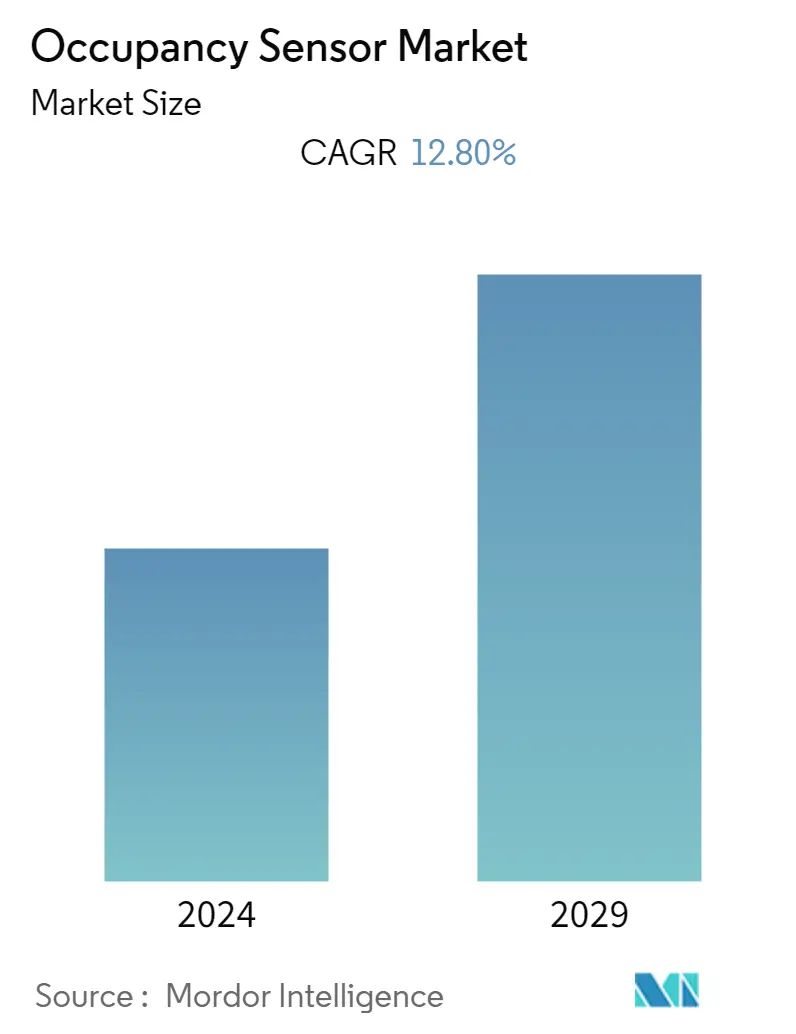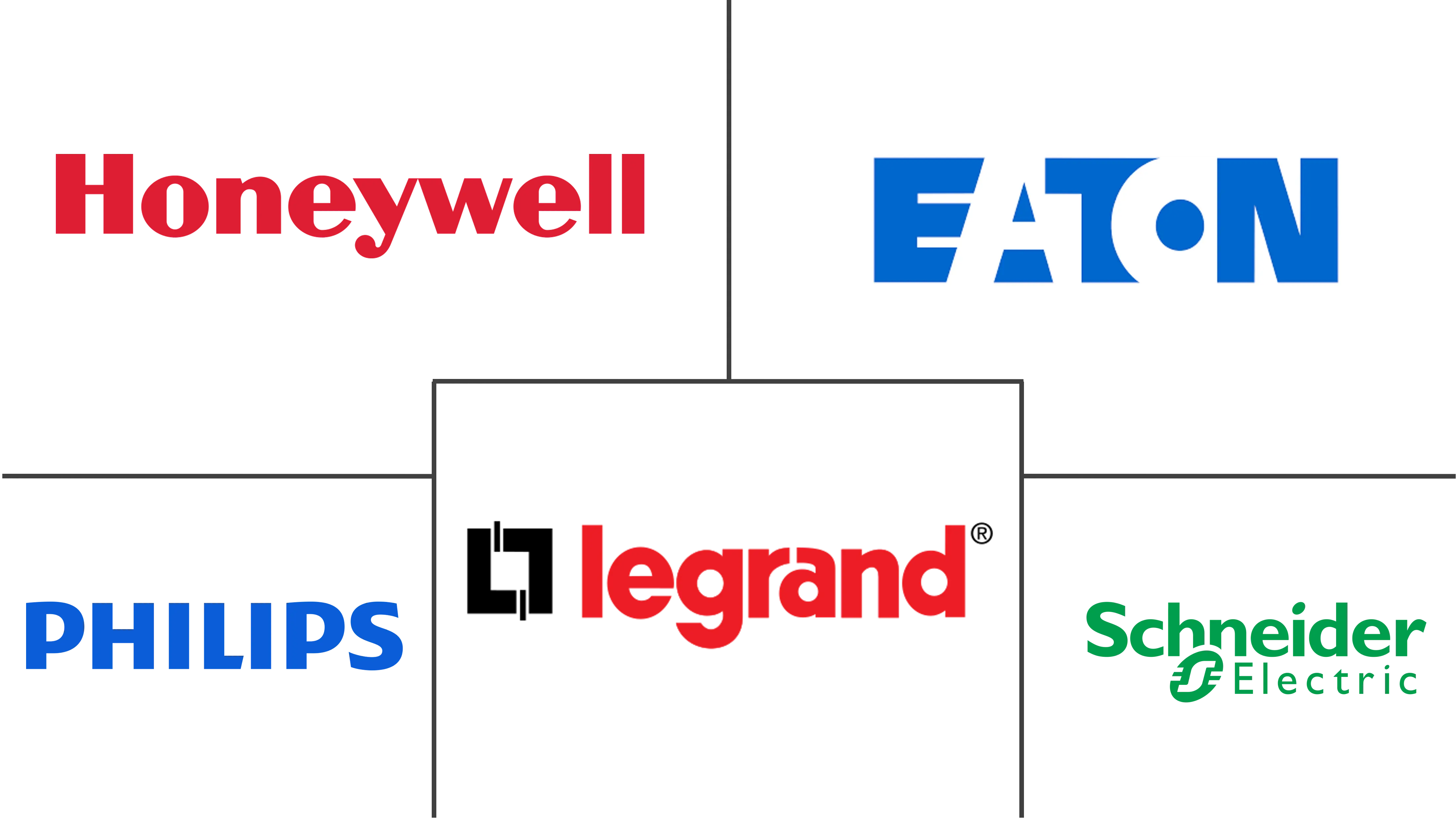Market Size of Occupancy Sensor Industry

| Study Period | 2019 - 2029 |
| Base Year For Estimation | 2023 |
| CAGR | 12.80 % |
| Fastest Growing Market | Asia Pacific |
| Largest Market | North America |
| Market Concentration | Low |
Major Players
*Disclaimer: Major Players sorted in no particular order |
Occupancy Sensor Market Analysis
The Occupancy Sensor Market registered a CAGR of 12.8% over the forecast period. Sensor-laden lighting systems now have industry acceptance for data-driven applications beyond lighting. In the coming years, OEMs (original equipment manufacturers) may integrate sensors in luminaires to create smart luminaires that can be an integral part of a connected lighting system. Thus, this may drive the market in the future.
- The global occupancy sensor market is expanding rapidly and will continue to expand in the near future. An occupancy sensor is an indoor motion detector that detects the presence of a person in order to operate lights, temperature, or ventilation systems automatically. It turns off lights in empty areas, lowering energy expenses by reducing energy waste.
- Furthermore, as scheduling becomes difficult with occupancy sensors, these are ideal for tasks requiring micro-control. Occupancy sensors are generally used for security purposes, such as preventing damage, burglary, and stealing. These are also utilized to give automatic control, conform with construction requirements, and conserve energy.
- The rising demand for energy-efficient devices is expected to drive the market. Occupancy sensors play a vital role in reducing energy consumption. This is achieved through the sensors, which shut down devices and other equipment on the basis of occupancy. These sensors help in reducing light pollution, and they can be used for indoor and outdoor spaces.
- The demand for passive infrared is expected to continue in the future due to the low cost, demand for energy-efficient devices, and less power requirement. It has a range of applications, such as lighting, spectrometers, gas and fire detection systems, etc. Some of the major benefits of passive infrared sensors are accurate movement detection, reliable triggering, and cost efficiency.
- Despite significant advertising, occupancy sensors are less developed than other lighting technologies, such as motion sensors and vacancy sensors. It is hampered by the difficulty of precisely forecasting the occupant's occupancy. An occupancy sensor's performance is affected by user occupancy, lighting control patterns, and sensor selection. Furthermore, it is regarded as expensive, and there is little awareness of the cost-related benefits of occupancy sensors. This is a barrier to the occupancy sensor market since it has an impact on penetration rates in developing and undeveloped economies.
- During the outbreak of COVID-19, the market witnessed a halt in production and disruption across the supply chain, leading to weakened growth of industrial output and the decline of the occupancy sensor output across significant manufacturing hubs. Manufacturing is anticipated to reach pre-COVID levels over the forecast period as construction of new homes and buildings picks pace.
- The pandemic affected the construction industry, which led to a slump in demand for occupancy sensors, as the newly constructed buildings in the residential and commercial sectors are primary areas of opportunity that support the market's growth. Owing to the restrictions put in place by the governments, all construction activities and most business activities across multiple countries have been affected.
Occupancy Sensor Industry Segmentation
The scope of the report covers the segments such as network type (Wired and Wireless), technology (Ultrasonic, Passive Infrared, and Microwave), building type (residential and Commercial), and application (Lighting Control, HVAC, and Security and Surveillance), and geography. An occupancy sensor is used to save energy, comply with building codes, provide automatic control, and various other such applications. One of the most widely used technologies among the occupancy sensors is passive infrared, which detects occupancy within a specific field and activates lighting, and is extremely useful in small spaces.
Moreover, the advent of advanced occupancy sensors, such as micro-phonics, intelligent occupancy sensors, image processing occupancy sensors, and the new vision-based intelligent occupancy sensor, for HVAC systems is fueling the growth of the occupancy sensor market.
| By Network Type | |
| Wired | |
| Wireless |
| By Technology | |
| Ultrasonic | |
| Passive Infrared | |
| Microwave |
| By Building Type | |
| Residential | |
| Commercial |
| By Application | |
| Lighting Control | |
| HVAC | |
| Security and Surveillance | |
| Other Applications |
| By Geography | |||||||
| |||||||
| |||||||
| |||||||
| |||||||
| Middle East and Africa |
Occupancy Sensor Market Size Summary
The occupancy sensor market is experiencing rapid expansion, driven by the increasing integration of sensors in lighting systems and the growing demand for energy-efficient devices. These sensors, which automatically control lighting, temperature, and ventilation based on occupancy, are becoming integral to smart building solutions. The market is further propelled by the trend towards smart cities, where occupancy sensors play a crucial role in managing urban infrastructure efficiently. Despite challenges such as limited awareness and higher costs, the market is poised for growth as urbanization and smart city developments continue to rise globally.
North America leads the occupancy sensor market, supported by a well-organized value chain and a focus on technological advancements. The region's demand is fueled by innovations like image processing and intelligent occupancy sensors, particularly in the residential and commercial building sectors. Key players are actively expanding their market presence through product diversification and strategic partnerships. The market's fragmentation is evident, with companies like Honeywell International, Eaton Corporation, and Legrand Inc. enhancing their offerings to maintain a competitive edge. Recent developments, such as the introduction of advanced sensors by Aqara and Wozart, highlight the ongoing innovation in the sector.
Occupancy Sensor Market Size - Table of Contents
-
1. MARKET DYNAMICS
-
1.1 Market Overview
-
1.2 Introduction to Market Drivers and Restraints
-
1.3 Market Drivers
-
1.3.1 Rising Demand for Energy-efficient Devices
-
1.3.2 Demand for Passive Infrared Due to Low Cost and High Energy Efficiency
-
-
1.4 Market Restraints
-
1.4.1 False Triggering of Switch and Inconsistency Issues Associated with Wireless Network Systems
-
-
1.5 Value Chain Analysis
-
1.6 Industry Attractiveness - Porter's Five Forces Analysis
-
1.6.1 Threat of New Entrants
-
1.6.2 Bargaining Power of Buyers
-
1.6.3 Bargaining Power of Suppliers
-
1.6.4 Threat of Substitute Products
-
1.6.5 Intensity of Competitive Rivalry
-
-
-
2. MARKET SEGMENTATION
-
2.1 By Network Type
-
2.1.1 Wired
-
2.1.2 Wireless
-
-
2.2 By Technology
-
2.2.1 Ultrasonic
-
2.2.2 Passive Infrared
-
2.2.3 Microwave
-
-
2.3 By Building Type
-
2.3.1 Residential
-
2.3.2 Commercial
-
-
2.4 By Application
-
2.4.1 Lighting Control
-
2.4.2 HVAC
-
2.4.3 Security and Surveillance
-
2.4.4 Other Applications
-
-
2.5 By Geography
-
2.5.1 North America
-
2.5.1.1 United States
-
2.5.1.2 Canada
-
-
2.5.2 Europe
-
2.5.2.1 United Kingdom
-
2.5.2.2 France
-
2.5.2.3 Germany
-
2.5.2.4 Italy
-
2.5.2.5 Rest of Europe
-
-
2.5.3 Asia Pacific
-
2.5.3.1 China
-
2.5.3.2 Japan
-
2.5.3.3 South Korea
-
2.5.3.4 Australia
-
2.5.3.5 Rest of Asia Pacific
-
-
2.5.4 Latin America
-
2.5.4.1 Mexico
-
2.5.4.2 Rest of Latin America
-
-
2.5.5 Middle East and Africa
-
-
Occupancy Sensor Market Size FAQs
What is the current Occupancy Sensor Market size?
The Occupancy Sensor Market is projected to register a CAGR of 12.80% during the forecast period (2024-2029)
Who are the key players in Occupancy Sensor Market?
Honeywell International, Eaton Corporation, Legrand Inc., Schneider Electric and Philips Ltd are the major companies operating in the Occupancy Sensor Market.

